In this overview, we've put together a list of kayak paddles that we think are worth your attention in 2023. There's also a buying guide to help you choose the best kayak paddle for your adventures. At a Glance: Best Paddles for Kayaking in 2023 Best Paddle for Beginners: Bending Branches Whisper Best Recreational/Touring Paddle: Aqua-Bound Sting Ray Posi-Lok Best High-Angle Recreational Paddle: Aqua-Bound Manta Ray Carbon Best Kayak Paddle for Fishing: Bending Branches Angler Classic Best Kayak Paddle for the Money: Bending Branches Sunrise Glass Best Whitewater Kayak Paddle: Werner Sherpa Best Kayak Paddle for Kids: Perception Hi Five…
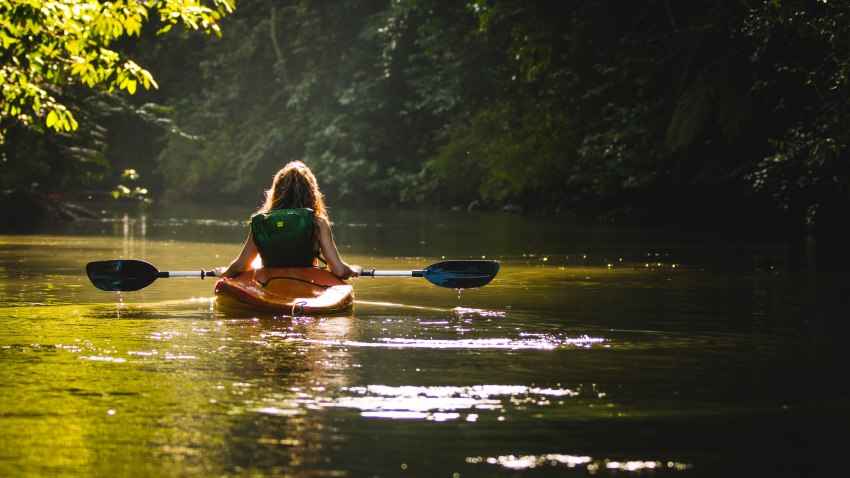
Picking your first kayak paddle is difficult, especially when you’re just getting started kayaking. We recommend Bending Branches Whisper as a great choice for any beginner.
The right paddle will feel like an extension of your body. The wrong paddle will have you straining and stretching, or even risking injury. Different paddlers have different needs and preferences, and it’s not as easy as just buying the same paddle your friend has.
RELATED: Best Kayaks for Beginners
How do you choose a paddle if you’re just starting out? In this article, we’ve reviewed some models that we consider the best kayak paddles for beginners. You’ll also find a comprehensive buying guide to help you make the right decision.
As an affiliate of Amazon and other retailers, we may earn a small commission when you buy via our links, at no additional cost to you. Thank you!
At a Glance: Best Kayak Paddle for Beginners
| Model | Specs | Where to Buy |
 Bending Branches Whisper | Shaft Material: Aluminium Blade Material: Polypropylene Weight: 37 oz. (1049 g) | Amazon |
 NRS PTR | Shaft Material: Aluminium Blade Material: High impact ABS plastic Weight: 44 oz. (1247 g) | Amazon |
Werner Tybee | Shaft Material: Fiberglass carbon blend Blade Material: Fiberglass reinforced nylon Weight: 36 oz. (1020 g) | Amazon |
 Bending Branches Bounce | Shaft Material: E-coat Aluminum Blade Material: Polypropylene Weight: 37 oz. (1049 g) | Campmor |
Best Paddle for Beginners: Bending Branches Whisper
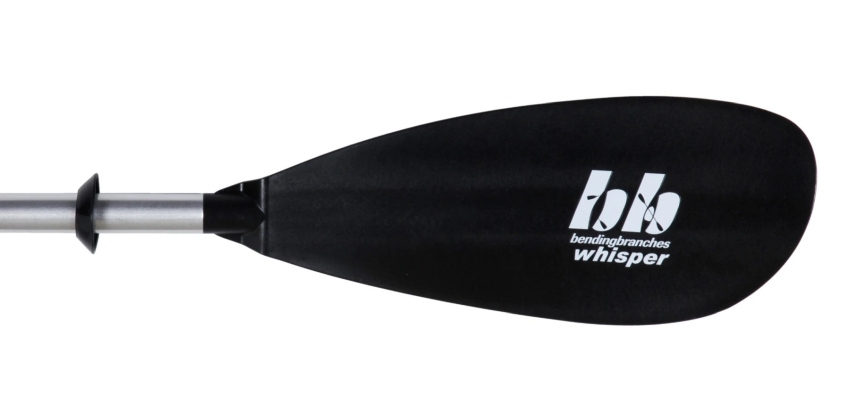
Shaft Material: Aluminium
Shaft Options: Straight shaft. 0° or 60° (Left or Right handed)
Blade Material: Polypropylene
Blade Dimensions: 6.75 x 18 in. (17 x 46 cm)
Blade Size: 89 sq. in. (574 sq. cm)
Lengths: 210 / 220 / 230 / 240 cm
Weight: 37 oz. (1049 g)
This is one of the best selling introductory paddles in North America, and for a good reason.
The Bending Branches Whisper is a solid, two piece paddle. This durable design combines an aluminum shaft with some polypropylene blades to create a paddle which can survive an enormous amount of abuse. When you’re starting out paddling, you’re likely to take a few knocks along the way, and it’s reassuring to know you’ve got a paddle which will take those knocks with you.
Don’t be fooled, though. This isn’t just a paddle to beat up and throw away when you’re done with it. It’s a solid, wobble free design which has streamlined asymmetric blades. The design makes the Whisper really easy to paddle with, and the adjustable ferrule lets you choose whether you want flat blades, or to control the paddle with your left, or right, hand.
These are an affordable option for anyone starting out, but bear in mind they come from a manufacturer who makes some of the most popular paddles available. They might be the introductory option for Bending Branches, but they’re a solid and reliable option for a beginner kayaker.
What we like
- Affordable price point
- Easy to use, great beginner option
What we don’t like
- At this price point, nothing
NRS PTR
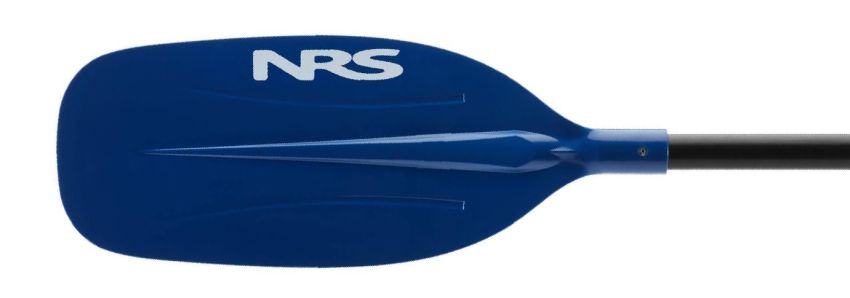
Shaft Material: Aluminium
Shaft Options: Straight shaft. 45° Right handed.
Blade Material: High impact ABS plastic
Blade Dimensions: 8 x 18 in. (20 x 46 cm)
Blade Size: 124 sq. in. (800 sq. cm)
Lengths: 197 / 200 / 205 / 220 / 230 / 240 cm
Weight: 44 oz. (1247 g)
When you’re looking for a beginner’s paddle, it doesn’t get much more straightforward than the NRS PTR paddle. Firstly, these are the only symmetric blades on the list, this means that it doesn’t matter whether you use them right way up, or upside down, they’ll work the same. Square blades are powerful and direct, and though they may lack some of the fineness of an asymmetric blade, beginners will benefit from how easy they are to use.
The strong aluminium blades and the stiff, sturdy plastic blades make this a really durable option, ideal for beginners who often end up bounding around rocks and shorelines as they get on and off the water.
NRS have taken away all the difficulty with choosing a paddle. They’ve simplified the process, by making this paddle in just the one option. You can get the PTR in right handed, with a 45° angle, a nice middle ground to get to grips with the strokes. If this angle works for you, there’s no reason you can’t progress with this paddle, but unlike others on this list, there’s no option to change it. Either like it, get used to it, or start again.
What we like
- Easy to use and understand for any paddler
What we don’t like
- Square blades are limited for performance strokes
- Limited options for feather and no left handed option
Werner Tybee

Shaft Material: Fiberglass carbon blend
Shaft Options: Straight shaft. 0° / 15° / 30° / 45° / 60° (Left or Right handed)
Blade Material: Fiberglass reinforced nylon
Blade Dimensions: 7.2 x 26.9 in. (18 x 68 cm)
Blade Size: 94.25 sq. in. (608 sq. cm)
Lengths: 210 / 215 / 220 cm
Weight: 36 oz. (1020 g)
It might be a bit unfair to throw the Tybee in the mix as a beginner’s paddle when it could quite easily have gone in with the best paddles for recreation, below. In reality, this is a fantastic paddle, as you would expect from a paddle manufacturer renowned worldwide as making some of, if not the best, paddles on the market.
The Tybee itself takes a step away from the other beginner paddles on this list. The carbon/fiberglass shaft and the fiberglass reinforced nylon blades don’t have the same strength as the aluminium shaft and plastic blades of the two paddles above, but as long as you’re happy that you’re not going to destroy your kit too quickly, it makes it a much nicer paddle to use.
The high angle blades promote proper paddling position and the asymmetric shape gives them a smooth catch and release of the water. The Tybee also has an adjustable ferrule, so you have a huge range of options when it comes to picking your feather.
It may come in at twice the price of the other two paddles on this list, but the Werner Tybee gives you the greatest longevity options of the three. It’s a paddle which is equally apt for beginners or recreational paddlers of all levels, so you won’t find yourself wanting to replace it any time soon.
What we like
- Progressive option
- Strong, smooth, high angle blades
What we don’t like
- Expensive compared to others on the list
Bending Branches Bounce
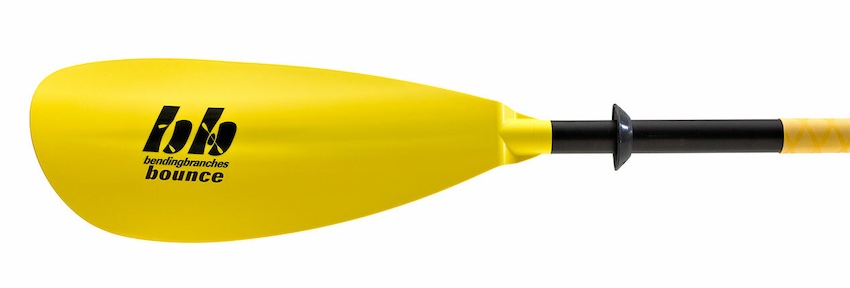
Shaft Material: E-coat Aluminum
Blade Material: Polypropylene
Lengths: 210 cm / 220 cm / 230 cm / 240 cm
Weight: 37 oz. (1049 g)
Blade Dimensions: 6.75 x 18 in. (17 x 46 cm)
Blade Surface Area: 89 sq. in. (574 sq. cm)
Ferrule Angles: 0° & 60° (L or R)
Bending Branches Bounce is a brilliant recreational paddle, perfect for days cruising around your local lake or down a gentle river with friends.
The bright yellow asymmetric blades stand out a mile off on the water, making you easy to spot in photos or if you need a bit of help. Their shape gives you a smooth and easy paddle stroke.
The color scheme extends to the x-grip on the shaft, designed to maximise your control and comfort as you paddle, while the remainder of the shaft is e-coated aluminium. Both durable and lightweight, this paddle is available with no feather or 60 degrees left, or right handed.
Best Paddles for Beginner Kayakers: Factors to Consider
Paddle Length: What Size Of Kayak Paddle Is Best?
There is no one rule for how long your paddle should be. Each manufacturer will have its own size chart. We have included some of these sizing guides in this section.
There are two main factors to consider when choosing the ideal paddle length for you. Your height and the width of your kayak will be the key pieces of information.
Sit-on-top kayaks, especially fishing kayaks, tend to be the widest boats on the market. If you paddle one of these, you will need a longer paddle. Sea kayaks or whitewater kayaks tend to be narrower and you will need a shorter paddle.
Aqua-Bound Kayak Paddle Sizing Guide
| Kayak Width | Under 23″ | 23″ to 27.75″ | 28″ to 32″ | Over 32″ |
| Paddler Height: Under 5′ | 200 cm | 210 cm | 220 cm | 230 cm |
| 5′ to 5’6″ | 210 cm | 220 cm | 230 cm | 240 cm |
| 5’7″ to 6′ | 220 cm | 220 cm | 230 cm | 240 cm |
| Over 6′ | 220 cm | 230 cm | 240 cm | 250 cm |
NRS Sizing Guide for Touring & Recreational Kayak Paddles
Low Angle
| Paddler Height | Boat Width | Paddle Length |
| 5’0″–5’10” | 21″–23″ | 220 cm |
| 5’6″–6’2″ | 23″–26″ | 230 cm |
| over 6’3″ | over 25″ | 240 cm |
High Angle
| Paddler Height | Boat Width | Paddle Length |
| 5’0″–5’10” | under 22″” | 210 cm |
| 5’6″–6’2″ | 23″–26″ | 215 cm |
| over 6’3″ | 23″–24″” | 220 cm |
For full sizing guides from different manufacturers, check the links below:
Aqua-Bound: https://aquabound.com/pages/kayak-paddle-sizing-guide
Bending Branches: https://bendingbranches.com/blogs/resources/kayak-paddle-sizing-guide
NRS: https://www.nrs.com/learn/paddle-sizing-guide
Blade Shape: High-angle vs. Low-angle Paddles
High-angle blades are short and wide. These paddles are designed to be held more vertically and generate more direct and powerful strokes. High-angle paddles work better with narrower kayaks and tend to be shorter.
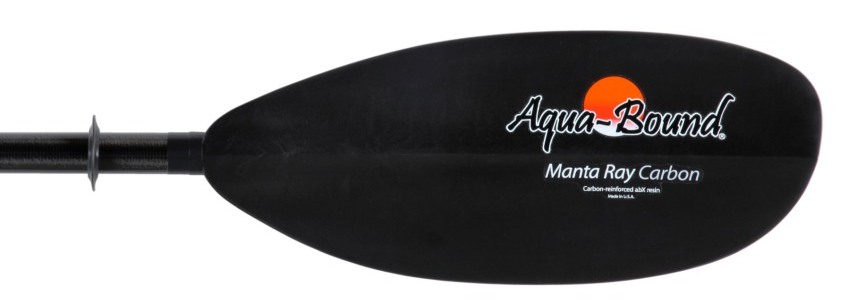
High-angle paddles are favored by paddlers in high-pressure environments, such as white water or coastal sea kayaking. With shorter and more powerful paddles, you can increase stroke rate and accelerate faster.
Low-angle blades are longer and narrower. Using low-angle blades with a more horizontal paddling style lets you get a more relaxed stroke which is ideal for cruising.
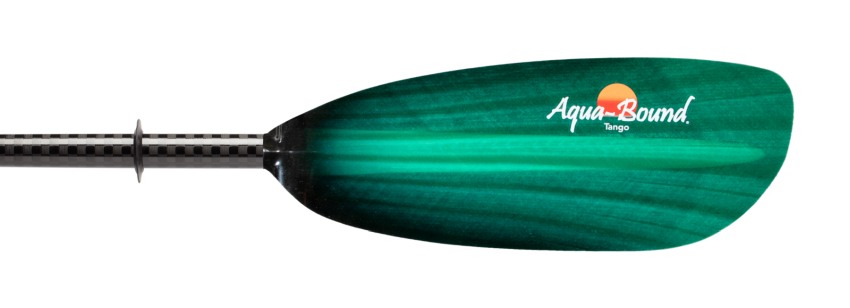
Low-angle paddles tend to be used by paddlers who are out on the water for many hours at a time. The relaxed position lets you cruise without over-straining yourself.
See our detailed post about the differences in high-angle and low-angle paddling.
Blade size
High- and low-angle blades may look very different but have a similar surface area. This surface area, or size, will affect how much water the paddle grips and how hard it is to pull.
Larger blades allow you to generate more direct power. Smaller blades are better suited for smooth paddling and linking strokes together. Many people find a happy medium with mid-sized blades but it can be worth trying out different sizes.
If you are a smaller paddler, large blades may even cause you injuries, as you will have to overstrain to use them. Many companies have certain paddles in their range for smaller framed paddlers.
Feather
You might have noticed that the blades of kayak paddles are often offset against each other. The idea of this (called “feather”) is that you get less air resistance from the blade that isn’t in the water. A higher angle of feather means you waste less energy on stroke recovery.
So why wouldn’t you always want a higher feather? Historically, paddles were almost always 90°. Using a high feather for a long time can cause repetitive injuries in your wrist as you have to continually twist your hand. Lower feather paddles have been introduced to combat this.
If you plan to go on long journeys and in windy conditions, a feather of up to 60° can conserve energy. If you are paddling in a more sheltered area, a low feather can protect your wrists and make it easier to master certain strokes.
One-piece or split paddles
One-piece paddles are usually slightly cheaper and are slightly more robust than split paddles. That said, paddle joints have become incredibly strong. They do limit your options though.
Split paddles are much easier to transport and store if you are short on space. They can also be carried on the water as a spare.
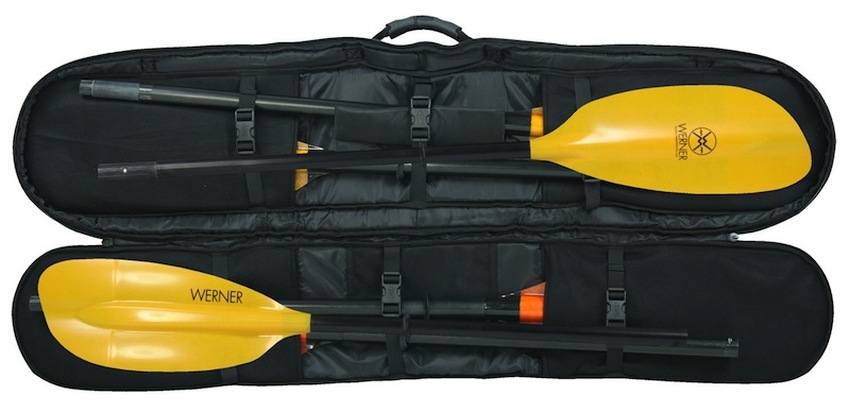
Many split paddles now have an adjustable feather. This ability to adjust on the go allows you to adapt to changing weather conditions or environments. Some split paddles also have an adjustable length.
This length adjustment is particularly useful if you have several kayaks or if you paddle a fishing kayak with a height adjustable seat. Adjusting your paddle length lets you always reach the water comfortably.
Bent or straight shaft
One way to negate some of the potential injuries from feathered paddles is to use a bent shaft. These bent shafts put your wrists at a more ergonomic angle and reduce strain. They do take some getting used to, though, and also increase the cost.

These bent shafts are also commonly used on paddles made purely of carbon. The lack of flex in carbon can put undue strain through your wrists and elbows, but this can be reduced with a bent shaft.
Materials: What Are Kayak Paddles Made Of?
Paddles are made of all sorts of different materials. The main four are aluminum, plastic, fiberglass, and carbon.
Aluminum
Aluminum is commonly used for the shafts of budget paddles. It’s strong, light, and durable, which ticks all the boxes.
Unlike other materials, aluminum isn’t as flexible or light. It also doesn’t have the same versatility and isn’t as comfortable to use, especially in cold weather.
Plastic
Nylon blades are the most robust option on the market. These are most commonly found on recreational paddles. More specialized plastic blades are often stiffened with either fiberglass or carbon to make them more responsive.
Plastic blades are often overlooked but they should not be considered as just a beginner option. These are strong and will outlast other blade types while also being far more affordable. Despite the reinforcement, they will never be quite as stiff as fiberglass or carbon blades.
Fiberglass
Fiberglass is a common blade choice among sea kayakers and white water paddlers but is suited to all types of paddling. Fiberglass kayak blades are stiff and powerful as well as being far lighter than plastic blades. They are less durable than plastic but withstand rocks and impacts well.
Fiberglass is the most common material used for paddle shafts. The stiffness and weight make it the ideal choice and it also retains some flex which helps to protect your wrists over time.
Carbon
Carbon is the lightest, stiffest, and most expensive material that kayak paddles are made of. Carbon blades are incredibly stiff and lightweight and tend to be favored by paddlers who benefit from either direct power or a lightweight paddle to swing all day. Carbon is far less durable and does not withstand impact nearly as well as other options.
Carbon shafts are lighter and stiffer than fiberglass. For this reason, they are often available with a bent shaft option.

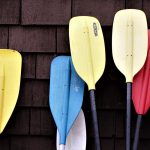
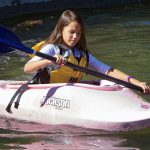
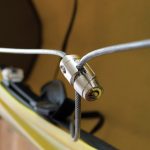
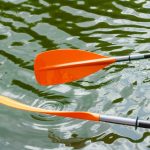
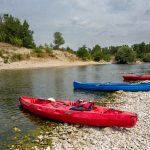
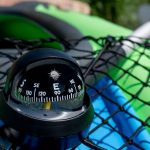
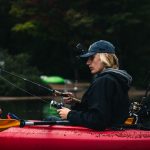
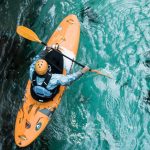

Wow!!! What a great comprehensive article!!!